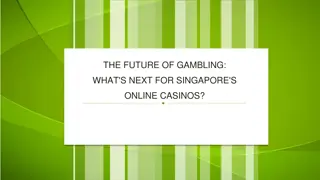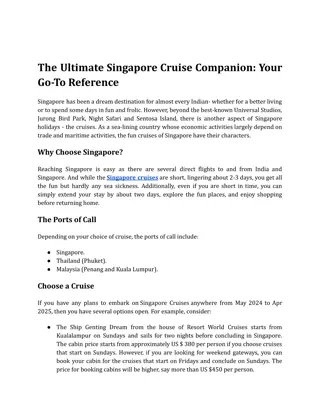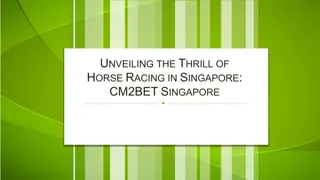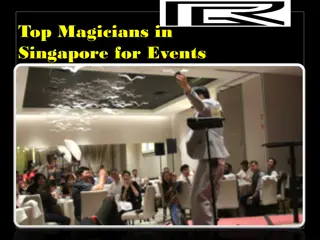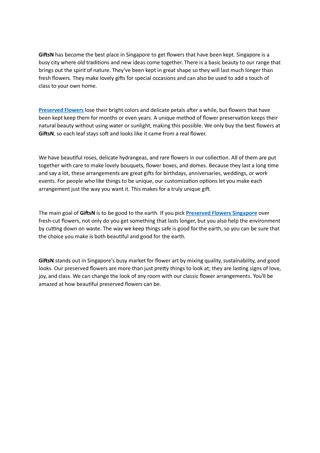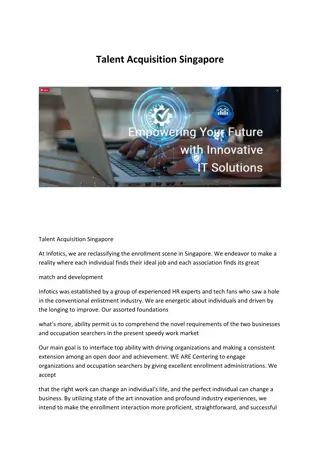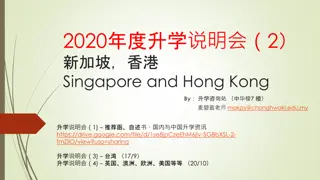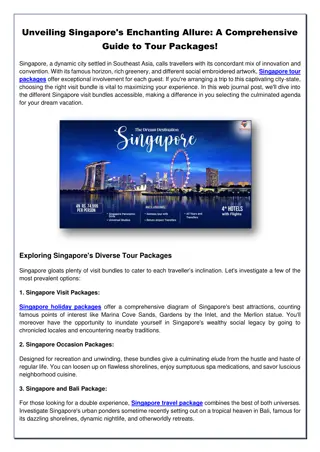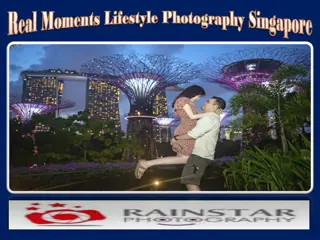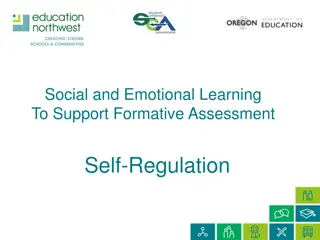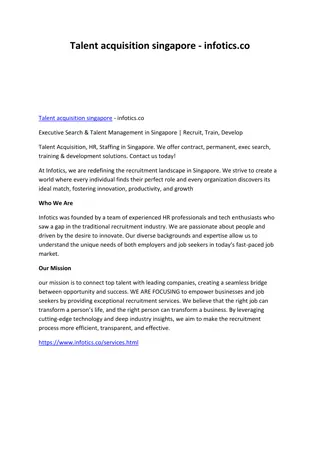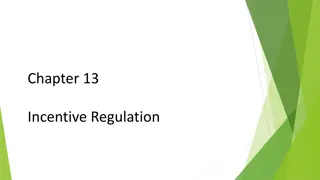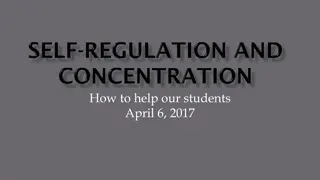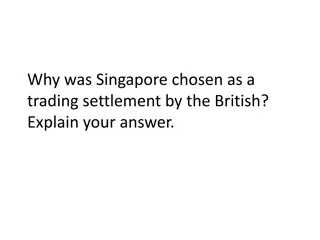Singapore Newspaper Regulation and History
Singapore has a rich history of newspaper publication, with regulations in place to govern the media landscape. The Newspaper and Printing Presses Act of 1974 plays a significant role in overseeing print media, ensuring accountability and adherence to government guidelines. Explore the evolution of newspapers in Singapore, from the early days of the Singapore Chronicle to the current landscape dominated by the Singapore Press Holdings (SPH) group. Learn about the social responsibility theory that underpins media practices in Singapore and the role of the government in regulating both local and foreign newspapers.
Download Presentation

Please find below an Image/Link to download the presentation.
The content on the website is provided AS IS for your information and personal use only. It may not be sold, licensed, or shared on other websites without obtaining consent from the author.If you encounter any issues during the download, it is possible that the publisher has removed the file from their server.
You are allowed to download the files provided on this website for personal or commercial use, subject to the condition that they are used lawfully. All files are the property of their respective owners.
The content on the website is provided AS IS for your information and personal use only. It may not be sold, licensed, or shared on other websites without obtaining consent from the author.
E N D
Presentation Transcript
Singapore Newspaper Heling Zhang Saud abdulaziz Hayat Tianjin Shi Yawen Zhang Zhe Yuan
Contents Introduction & History Newspaper regulation Domestic Press in Singapore The Foreign Press and Singapore Theories Social function of the media system Fake news law: POFMA Conclusion
Introduction & History Singapore s largest newspaper group -SPH It currently owns 17 newspapers and 16 magazines Formed on 4 August 1984 the digital editions of SPH newspapers enjoy over 360 million page views with 23 million unique visitors every month The First Newspaper -the Singapore Chronicle s Singapore s first broadsheet was published on 1 January 1824, five years after the founding of Singapore Published once a fortnight on Thursdays Remained the only newspaper published in Singapore until 1835 ceased publication after 30 September 1837 Tan, S. C 1950
News paper regulation Media regulations are formal and enforced guidelines about the organization , behaviour, or content of the media. Theories of the press; Authoritarian theory, Libertarian theory, Social responsibility theory, and Soviet-Communist theory(McQuail,n.d) Singapore fits into social responsibility theory, which emphasizes on media accountability (Qi et al, n.d). Newspapers are ranked as the number one source of news in Singapore.
News paper regulation In Singapore, Print media is regulated using the Newspaper and Printing Presses Act (NPPA) of 1974 (Tey 2008) Some provisions of NPPA include (i)The chief editor or the news proprietor must obtain a permit from the government that authorizes publication. (ii) The government has the power to grant refuse, revoke or grant under conditions the publication permit at its own will. Under this act, newspapers are forced to play to government rules.
News paper regulation The Executive must approve Foreign newspapers for circulation and sale (Whiting & Majoribanks 2013). Circulated newspapers must abide by the jurisdiction of Singapore courts (Tey 2008) The jurisdiction gives the executive power to sue the newspapers that break the Newspapers Act. Government officials form part of board members of the newspapers.
Domestic Press in Singapore Nation building is the top priority in Singapore (Lee 1987). -Leading company : Singapore Press Holdings (SPH) -Uncooperative publications will be arrested and even be deported. - Sara (2000) argues that Singapore issue more licenses bring more domestic competitions. Economy government: development under the control from the 17 newspapers in Singapore won about 79% of readers in Singapore(ICD Research Reports 2014). Statistic from ICD: Threats: Newspaper and Magazine segment revenue accounted for 80.99% of total revenue in SPH which means SPH overdependence on newspaper and this will be threatened by digitization .(ICD Research Reports 2014). Sara (2000) points out government-owned broadcaster Media Corp got newspaper licenses will affect SPH. (ICD Research Report 2014)
The Foreign Press and Singapore Lee (cited in The Journalism School of Columbia University n.d.) asserted the foreign press has no right to interfere politics and Singaporean should not be impacted by ideological biases from foreign newspapers. Cases in Singapore: In 1986, Singapore passed and implemented a new law for the minister to restrict foreign press. In 2020, Singapore implemented POFMA, finally the PAP won the general election. Political advantages: Oppress oppositions (oppositions use foreign press to induce people) Maintain the PAP image in people s hearts Prevent imperialism Political threats: Pressure and Voices from other countries and foreign journalists. (Wikipedia 2020)
Theories Nation building should be the priority in Singapore embodies the Asian values that community is on the top position rather than individualism (Wendy 2002). Media imperialism includes ideological invasion (Chadha& Kavoori 2000). Press freedom can be restricted according to the development needs of that society (Sandy 2020).
Social function of the media system 1. The Singapore press has a pivotal role in fostering consensus politics , promote relations between the people and the government. Existence of censorship media can have negative effects on their consumers media reports have caused racial riots and the shedding of blood in the past widespread support of Singaporeans Therefore, censorship in Singapore is justified on historical as well as socio- political grounds, favouring caution and prevention over liberalism.
2. Fostering social cohesion and social stability Singapore s population structure is very complex, so Singapore media have to be socially responsible because citizens should not be influenced by the media to be against other ethnic or religious groups. Press control can foster bridges between the various ethnic communities that make up Singaporean society eg. The 1950 Maria Hertogh riots The 1964 riots during Prophet Muhammad's birthday The 1969 riot spillover from Malaysia. These riots have been blamed partly on uninhibited reporting and are often cited as examples of how the press can incite racial and ethnic violence.
3. Preventing the electronic communication of falsehoods Harms of fake news to Singapore: Be prejudicial to Singapore s security; Be prejudicial to public health, public safety, public tranquillity or public finances; Be prejudicial to the friendly relations of Singapore with other countries; Influence the outcome of a presidential election, general election, by-election or referendum; Incite feelings of enmity, hatred or ill-will between different groups of persons Diminish public confidence in the government.
Fake news law: POFMA ` (Protection from Online Falsehoods and Manipulation Act) prevent the electronic communication of falsehoods by online platforms of digital means A person must not commit any acts, whether in or outside of Singapore, to communicate a statement which that person knows or has reason to believe that it is a falsehood Individuals in breach of the law will be liable to a fine up to S$50,000 and/or a term of imprisonment up to 5 years. For non-individuals (e.g. online media platforms run by tech companies), a fine of up to $S500,000 will be imposed.
Conclusion In order to reduce the negative effects on consumers and avoid the riots , the censorship system in Singapore is strict . Government are maintaining the social stability and their party status by any means to keep the control of newspaper. A refined press control system A political institution In the recent few decades, a refined press control system has built in Singapore. It plays a significant role in maintaining the political status quo of Singapore. Singapore s specific news control system has transformed the press into a political institution. news Play a constructive role in society, rather than a watchdog role. Their function is to report facts by pointed out what happened, rather than giving any comment or raise any question.It is like copy and paste. In the most countries , news should be divided from government power but .Singapore model implies the need for protection of the executive power from the press
References Ang, P 1996, Censorship and the Internet: A Singapore Perspective, Communications of the ACM, viewed 5th <https://www.researchgate.net/publication/220420945_Censorship_and_the_Internet_A_Singapore_Pe rspective> August, Bokhorst-Heng, W 2002, Newspapers in Singapore: A Mass Ceremony in the Imagining of the Nation, Media Culture & Society, <https://www.researchgate.net/publication/268338127_Newspapers_in_Singapore_A_Mass_Ceremony _in_the_Imagining_of_the_Nation> viewed 22th August, By, S.W. 2000, Singapore Reveals Plan To Issue Media Licenses --- State Opens Up Competition, but Keeps Control, Victoria, com.ezproxy.lib.rmit.edu.au/docview/315455924/8E6D4B3F354444B7PQ/3?accountid=13552>. Hong Kong,<https://search-proquest- Chadha, K. and Kavoori, A. (2000) Media imperialism revisited: some findings from the Asian case , Media, Culture & Society, 22(4), com.ezproxy.lib.rmit.edu.au/doi/abs/10.1177/016344300022004003#articleCitationDownloadContaine r>. pp. 415 432, <https://journals-sagepub- Julia, L (n.d.), Settle or fight? Far Eastern Economic Review and Singapore , School of Journalism in Columbia <https://ccnmtl.columbia.edu/projects/caseconsortium/casestudies/1/casestudy/www/layout/case_id_1. html>. University, McQuail, D. 2. Media Theory, Policy, Regulation and Accountability. Retrieved 20 August 2020, from Qi, W, Yi, P, Wen, N, Qi, L, Jaclyn & Liang, T, n.d. Analysis Of Singapore Media System. [online] Media Systems of Singapore and Malaysia. Available at: . Sandy, W 2020, Asian media - liberal and partnership perspectives , PowerPoint slides, COURSECODE, RMIT University, Melbourne.
References Singapore Legal Advice 2020, Singapore Fake News Laws: Guide to POFMA (Protection from Online Falsehoods and Manipulation Act), Singapore Legal Advice 2020, viewed 14th August, <https://singaporelegaladvice.com/law-articles/singapore-fake-news-protection-online-falsehoods- manipulation/#codes> Singapore Press Holdings Limited : Media - Company Profile, SWOT & Financial Report2014, , GlobalData plc, com.ezproxy.lib.rmit.edu.au/docview/1553103831/88FF82990B7B44B1PQ/1?accountid=13552>. Tan, S. 1950,. The first newspaper in the colony. The Straits Times , NewspaperSG. Retrieved 5 January p. 6. London,<https://search-proquest- Tey, TH 2008, 'Confining the freedom of the press in Singapore: A "Pragmatic" Press for "nation- building"?', Human Rights Quarterly, vol. 30, no. 4, pp. 876-905. doi:10.1353/hrq.0.0034 Wendy, D 2002, Newspaper in Singapore: A Mass Ceremony in the Imagining of the Nation , Media Culture & Society :10.1177/016344370202400407<https://www.researchgate.net/publication/268338127_Newspapers_in _Singapore_A_Mass_Ceremony_in_the_Imagining_of_the_Nation>. 24(4), doi Whiting and Majoribanks 2013, MediaProfessionals Perceptions of Defamation and Other Constraints upon News Reporting in Malaysia and Singapore Democracy, Media and Law in Malaysia and Singapore. Wikipedia 2020, 1984 Singaporean general election, Wikipedia, viewed 22 August 2020, <https://en.wikipedia.org/wiki/1984_Singaporean_general_election>.






